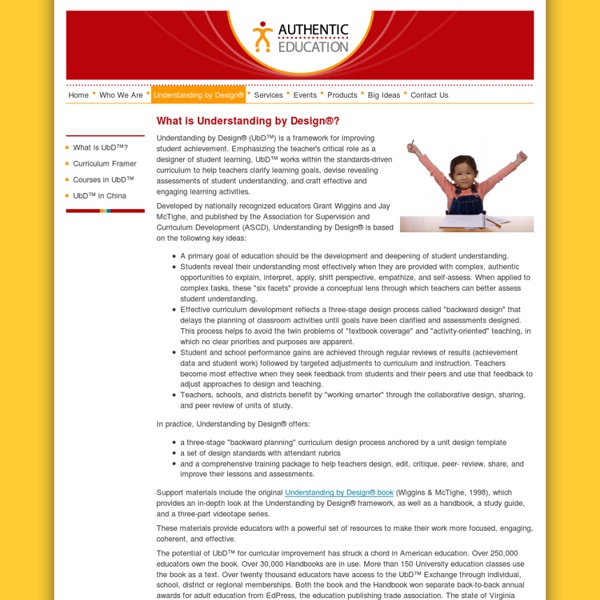A.2 How does this work? - Ed Tech Challenge
Question: How do I start? Answer: You've already started! Just keep clicking the green arrow at the bottom of the page. Question: Do I have to follow a timeline? Answer: You can take this course at your own pace. Question: Can I have an overview of what I will be creating this year? Answer: Your first task will be to transfer all your text and presentation documents into Google Apps and create a paperless classroom so that you can collaborate more efficiently with students and coworkers. Question: How will my progress be tracked? Answer: Your demonstration of learning will be represented by your Ed Tech Challenge Portfolio. Question: Is this course tied to any standards? Question: Will I get credit for this course? Answer: TBD. Learn more about the software we chose for this course.
Model Curriculum - Curriculum and Instruction
Focus of K2 This video of the kindergarten classroom in a Boston Public School provides a look at curriculum and instruction using Focus on K2 (kindergarten), which was created by Boston Public Schools' Early Childhood Department. A grant called Focus on Early Literacy allowed teachers, instructional assistants, principals and specialists in several districts in Massachusetts to participate in professional development and implement one 8-week unit from Boston's Focus on K2 curriculum in the spring of 2015. Coming Soon! The ESL MCUs take a functional approach to language teaching and are organized around WIDA’s Key Uses of Academic Language. As part of a Race to the Top Grant, the Massachusetts Department of Elementary and Secondary Education (ESE) has developed over 100 Model Curriculum Units (MCUs.) These MCUs were created by teams of teachers from across the Commonwealth with guidance and support from ESE curriculum and content specialist. MCUs for grades PK-12 in Testimonials
UbDQuikvue1005.pdf
AAAS News Release - "Systemic School Reform Necessary for Science Education Improvements"
Improving education in science, technology, engineering and mathematics (STEM), a bipartisan goal backed by politicians and business leaders alike, will require a new approach that views education as part of a larger, more complex enterprise that reaches far beyond the classroom, speakers said at a recent AAAS event. They spoke of using a systems approach to understand how STEM education works and doesn’t work—how components of the system, in school and beyond, interact and how they reinforce each other’s strengths and weaknesses. Researchers are using models to understand those interactions, with a goal of transforming the STEM education system for the 21st century. Rick Stephens “If we think about what’s going on in education, we tend to be focused on the policy about what’s going on inside the classroom,” said Rick Stephens, senior vice president of human resources and administration for the Boeing Corporation. The need to reach students is clear, Stephens said. Shirley Malcom
A New Way to Learn
Traditional Computer Based Learning (CBL) methods typically rely on one-way transmission of information. These methods are seen as extensions of classroom learning and thus viewed by children as restrictive. Consequently, results from such CBL initiatives have, at best, been mixed. In Contrast, Hole-in-the-wall Learning Stations seek to create a new paradigm in the learning process by providing unrestricted computer access to groups of children in an open playground setting. We believe that such an open setting will use child’s natural curiosity to stimulate learning. The essential features are: - The learning station is set up in an outdoor playground setting which children can access at any time. The playground setting offers a host of other advantages. - The learning station fosters collaborative learning among groups of children instead of following the usual school model of rote based learning (unidirectional). - The Learning Stations are used for various real life projects.
JaysMasterHandoutfor%20CAIM%202014.pdf
EARLI
Cornerstone%20Assessments(1).pdf
Journal of Educational Technology & Society
McTighe%20-%20Cornerstone%20Tasks%207.13.12.pdf
Shifting Perspectives in Educational Technology
Note: This article was originally published in The Technology Source ( as: Dirk Rodenburg "Shifting Perspectives in Educational Technology" The Technology Source, December 1998. Available online at The article is reprinted here with permission of the publisher. When we begin to seriously discuss what it means to learn, some interesting things happen. Although we begin by feeling that we share some understanding of what learning means, it rapidly becomes clear that there is a broad range of perspectives, each passionately articulated and defended. Pedagogical Frameworks and Educational Technology Educational technology has also shifted as these perspectives have emerged. Constructivism A very important theoretical perspective, developed and influenced largely by science teaching, is constructivism. Situated Cognition and Cognitive Apprenticeship Extending the Paradigm Implications for Educational Technology
McTighe on Cornerstone Tasks.pdf



